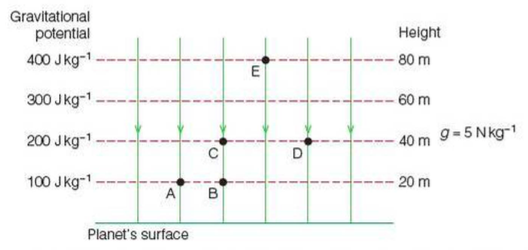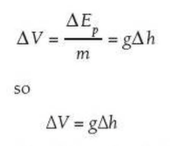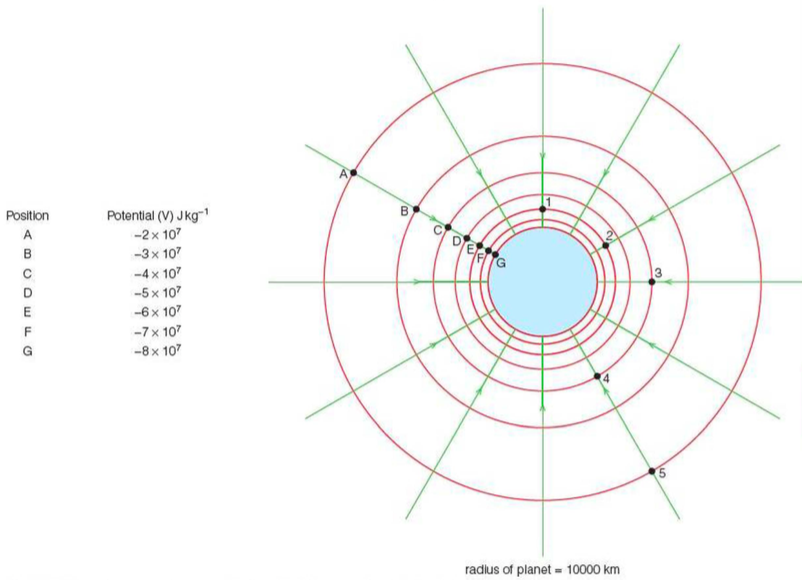Gravitational Potential
Summary
⇒ You will be familiar with the equation that we use to calculate the increase in gravitational potential energy when a mass is lifted in a gravitational field
⇒ We calculate the change of gravitational potential energy using the equation: ΔEp = mgΔh
- Where m is the mass lifted in kg, g is the gravitational field strength in Nkg-1, and Δh is the increase in height

⇒ This shows the gravitational field lines (in green) close to the surface of a planet, where the gravitational field strength is 5Nkg-1
⇒ When a 1kg mass if lifted through a height of 20m in this field, the equation above tells us that the increase in gravitational potential energy of the mass is 100J
- When the mass is lifted through 40m the increase in potential energy becomes 200J
⇒ These calculations lead us to the idea of gravitational potential difference, which can be defined as the change in gravitational potential energy per kilogram
⇒ Gravitational potential is given the symbol V, and gravitational potential difference is given the symbol ΔV. Since ΔEp = mgΔh, it follows that:

⇒ Gravitational potential has units of Jkg-1
Equipotential Lines
⇒ The above image also shows equipotentials close to the surface of the planet
⇒ In the diagram these look like lines, but in three dimensions they are surfaces
- On the diagram, equipotential surfaces have been drawn at intervals of 100Jkg-1
- When an object moves along an equipotential, it means that the potential (and therefore the potential energy) stays the same
⇒ Equipotential surfaces are always at right angles to the gravitational field
- When something moves at right angles to the field (and hence along an equipotential), no work is done by or against the gravitational field, so there is no potential energy change
- When something moves along a field line, there is a change of gravitational potential energy
⇒ To be exact, in the link between gravitational field and potential, we should link them with this equation:

⇒ The significance of the minus sign is that the potential gradient ΔV / Δh is in a positive direction upwards, because the potential increases as the height about the planet increases
- The gravitational field direction is downwards
Gravitational Potential in Radial Fields
⇒ Look at the following graph: this shows how the gravitational force acting on an object (with a certain mass, m) changes as it approaches a planet (with a distinct mass, M):

⇒ This graph shows that at a certain distance from the planet (r) a force is acting on the object
⇒ If this object were to move a small distance away form the planet (Δr) we are able to calculate how much the gravitational potential energy increases:

- FΔr will usually be written as mgΔh because of the fact that the force (F) that acts on the mass is equal to its weight (i.e. mg = mass x gravitational field strength)
⇒ Calculating the increase in gravitational potential energy when the mass is moved much greater distances (e.g. r1 to r2) is a little trickier because the force moves as the distance moves
⇒ In this scenario, we can calculate the gravitational potential energy as follows:

⇒ Using this equation, we can derive a formula for the increase in gravitational potential (ΔV), because:

⇒ This equation allows us to think about defining gravitational potential close to a planet
- We can calculate the potential change in moving from a distance r1 to a point infinitely far from the planet
⇒ When r2 is equal to infinity, 1/r2 is essentially 0, so the gravitational potential change in moving from r1 to inifinity is:

⇒ However, we choose to define infinity as the point of 0 gravitational potential for all stars and planets
- If we chose any other point as 0 (e.g. surface of Earth), we would get far more complicated equations when dealing with potentials close to other planets
⇒ Therefore, as we defined the gravitational potential as 0 at inifinity, it means the gravitational potential near to any planet is a negative quantity, because gravitational potential energy will decrease as an object falls towards a planet
⇒ This leads to the following definition of gravitational potential (V) of an object positioned at a distance (r) from the centre of some massive object:

Gravitational Field Lines
⇒ The following image shows the gravitational field lines and equipotentials near a planet:

⇒ The equipotentials are shown in equal steps of 1 x 107 JKg-1 from the surface of the celestial body (at G), where the potential is -8 x 107 JKg-1, to A, where the potential is -2 x 107 JKg-1
⇒ The diagram shows two important linked points:
- The potential gradient is steeper close to the planet's surface, because the equipotentials are closer to the planet's surface
- The field lines are closer together near the surface, because the gravitational field strength, g, is stronger
⇒ These two statements are linked by a formula shown earlier:

⇒ These equations are exactly the same, except that Δh has been used for a change in height, and Δr has been used for a change in distance from the centre of the planet
Extra
⇒ Also see our notes on: